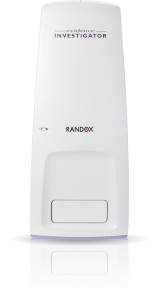Acute Kidney Injury
Acute Kidney Injury
Multiplex Detection of Acute Kidney Injury from a Single Sample
Acute kidney injury (AKI) is currently diagnosed using serum creatinine as recommended by the KDIGO guidelines. Serum creatinine however, has poor sensitivity and specificity for AKI lagging behind both renal injury and recovery. There is an immediate need for more sensitive biomarkers to enables earlier identification of AKI, monitor drug toxicity and identify patients at an increased risk of CKD, end-stage renal disease or long-term kidney dialysis.
The National Institute for Health and Care Excellence (NICE) has highlighted that is important that patients are assessed for AKI on admission to hospital or transfer, monitored for AKI throughout their stay and AKI is managed appropriately if it develops.
Utilising patented Biochip Technology, the Randox Acute Kidney Injury (AKI) array simultaneously tests for four novel biomarkers delivering early diagnosis and monitoring of treatment efficacy It may also help you conduct safer and faster clinical trials.

Randox Acute Kidney Injury (AKI) Array (4-plex)
This marker is highly upregulated in kidney tubule cells following nephrotoxic injury severe enough to result in acute renal failure, acute tubular necrosis or acute tubulo-interstitial nephropathy.
Due to its small size and basic pH, Cystatin C is freely filtered by the glomerulus. It is then reabsorbed by tubular epithelial cells and subsequently metabolized. Accumulation of Cystatin C in urine is specific for tubular kidney damage and suggests reduced reabsorption at the proximal tubules as a result of toxicant-induced kidney injury.
Expression of Clusterin is upregulated following a variety of renal injuries and is detectable in urine following acute kidney injury induced by administration of nephrotoxic agents. This occurs before the profound renal transformations that give rise to changes in creatinine and BUN.
KIM-1 is a 30kDa type 1 transmembrane glycoprotein found on actvated CD4+ T cells. It is undetectable in healthy kidney tissue but is expressed at very high levels in proximal tubule epithelial cells in the kidney after toxic injury.
The Evidence Investigator
Meet the Evidence Investigator
The Randox AKI array has been developed for the Evidence Investigator, a semi-automated benchtop immunoassay analyser.
The AKI array would improve patient risk stratification whilst monitoring the effectiveness of treatments & drug toxicity by simultaneously and quantitatively detecting multiple urine biomarkers of kidney damage-related analytes from a single sample.

Want to know more?
Contact us or visit our Investigator Webpage
Obesity and Kidney Disease: What is the Connection?
30th January 2019
Obesity and Kidney Disease: What is the Connection?
The month of January has forever been the month of resolutions with many choosing to ditch the sweets and join the gym. However, for many these efforts are limited to January and bad habits are quick to remerge. Obesity has been a burden on the health service for many years with the problem, like many people’s waist lines, only continuing to expand.
Recent findings have shown that this problem is no longer just increasing in developed countries but also in developing countries. In fact, worldwide obesity has tripled since 1975. In 2016, more than 1.9 million adults were classed as overweight, of which over 650 million were obese.1 These are shocking statistics for a condition that is preventable. As a global concern, it is important to assess all the potential risks of this problem.
The most common diseases associated with obesity are cardiovascular disease (CVD) and diabetes. However, the associated risks are much greater than this. Being overweight may also increase the risk of certain types of cancer, sleep apnea, osteoarthritis, fatty liver disease and kidney disease.2
Obesity is now recognised as a potent risk factor for the development of renal disease.3 Excess weight has a direct impact on the development and progression of chronic kidney disease (CKD). Globally, the prevalence of diabetic kidney disease rose by 39.5% between 2005 and 2015, coinciding with the increased CKD prevalence.4 In obese individuals, the kidneys have to work harder, filtering more blood than normal to meet the metabolic demands of increased body weight, increasing the risk of kidney disease.
The traditional diagnostic test for renal impairment is creatinine. This test is carried out through the measurement of creatinine levels in the blood to assess the kidneys ability to clear creatinine from the body. This is called the creatinine clearance rate which helps to estimate the glomerular filtration rate (GFR), which is the rate of blood flow through the kidneys.5
Problems arise when using creatinine for CKD testing as a number of factors need to be taken into consideration including age, gender, ethnicity and muscle mass. For this reason, black men and women exhibit higher creatinine levels than white men and women, raising concern over the accuracy of this test for certain patient groups.6 In addition, serum creatinine is not an adequate screening test for renal impairment in the elderly due to their decreased muscle mass.7
The main disadvantage of using creatinine to screen for renal impairment is that up to 50% of renal function can be lost before significant creatinine levels become detectable as creatinine is insensitive to small changes in GFR. Consequently, treatment is not provided at the appropriate time which can be fatal, therefore, an earlier and more sensitive marker for renal function is vital.8
These disadvantages have not only been highlighted in research but also by the national institute for health and care excellence (NICE). NICE updated the classification of CKD in 2004 to include the albumin: creatinine ratio (ACR). They split chronic kidney disease patients into categories based on GFR and ACR. Figure 1 highlights the different categories and risk of adverse outcomes. NICE recommend using eGFR Cystatin C for people in the CKD G3aA1 and higher.9
Figure 1 Classification of Chronic Kidney Disease using GFR and ACR categories.9

Despite these suggestions, Creatinine is still being used for G3a1 and increasing risk levels.
The utility of cystatin C as a diagnostic biomarker for kidney disease has been documented to show superiority of traditional CKD tests. There is no ‘blind area’ making it very sensitive to small changes in GFR and capable of detecting early reductions. Furthermore, this marker is less influenced by diet or muscle mass and has proven to be a beneficial test in patients who are overweight.8
A number of studies support the statement: ‘Cystatin C levels are higher in overweight and obese patients’. This is important because when cystatin c levels are too high, it may suggest that the kidneys are not functioning properly. One study conducted, using a nationally representative sample of participants, found that overweight and obesity maintained a strong association with elevated serum cystatin C. This suggests that weight can affect the levels of cystatin C and therefore the likelihood of developing kidney disease.10
How Randox can Help
The Randox automated Latex Enhanced Immunoturbidimetric Cystatin C tests offers an improved method for assessing CKD risk, combined with a convenient format for routine clinical use, for the early assessment of at risk patients. Randox is currently one of the only diagnostic manufacturers who offer an automated biochemistry test for Cystatin C measurement, worldwide.
Want to know more?
Contact us or visit our featured reagent page to learn more.
Related Products
Randox Reagents
Resource Hub
References
- World Health Organization. Obesity and Overweight . int. [Online] WHO. [Cited: January 22, 2019.] https://www.who.int/news-room/fact-sheets/detail/obesity-and-overweight.
- Health Risks of Being Overweight. NIDDK. [Online] National Institute of Diabetes and Digestive and Kidney Diseases. [Cited: March 24, 2019.] https://www.niddk.nih.gov/health-information/weight-management/health-risks-overweight.
- Kidney Health Australia . Obesity and Chronic Kidney Disease: The Hidden Impact. Kidney Health Week/ World Kidney Day 2017. [Online] Kidney Health Australia. [Cited: January 22, 2019.] https://kidney.org.au/cms_uploads/docs/kidney-health-australia-report-obesity-and-chronic-kidney-disease–the-hidden-impact_06.03.17.pdf.
- Neuen, Brendon Lange, et al. Chronic kidney disease and the global NCDs agenda. s.l. : BMJ Global Health, 2017
- Creatinine and Creatinine Clearance Blood Tests. WebMD. [Online] WebMD. [Cited: January 22, 2019.] https://www.webmd.com/a-to-z-guides/creatinine-and-creatinine-clearance-blood-tests#1.
- Lascano, Martin E and Poggio, Emilio D. Kidney Function Assessment by Creatinine-Based Estimation Equations. Cleveland Clinic. [Online] August 2010. [Cited: 16 May 2018.] http://www.clevelandclinicmeded.com/medicalpubs/diseasemanagement/nephrology/kidneyfunction/.
- Swedko, Peter J, et al. Serum Creatinine Is an Inadequate Screening Test for Renal Failure in Elderly Patients. Research Gate. [Online] February 2003. [Cited: 6 May 2018.] https://www.researchgate.net/publication/8243393_Serum_Creatinine_Is_an_Inadequate_ Screening_Test_for_Renal_Failure_in_Elderly_Patients.
- Mishra, Umashankar. New technique developed to detect chronic kidney disease. Business Line. [Online] 07 May 2018. [Cited: 17 May 2018.] https://www.thehindubusinessline.com/news/science/new-technique-to-detect-chronic-kidney-disease/article23803316.ece.
- National Institute for Health and Care Excellence. Chronic kidney disease in adults: assessment and management: 1 Recommendations. National Institute for Health and Care Excellence. [Online] January 2015. https://www.nice.org.uk/guidance/cg182/chapter/1- recommendations#classification-of-chronic-kidney-disease-2.
- Overweight and Obesity and Elevated Serum Cystatin C Levels in US Adults . Muntner, Paul, et al. 4, s.l. : NCBI, 2008, Vol. 121.
Is Biomarker Multiplexing the future of kidney disease screening?
Chronic Kidney Disease (CKD) is both a cause and a consequence of cardiovascular diseases, and is an increasing burden on global health. As diabetes, obesity and hypertension incidences continue to rise and the world’s population steadily ages, CKD’s prevalence is already estimated to be between 11% and 13% globally for all five KDOQI stages, with a majority in Stage 3 (about 90% of all stages).
With early stages of CKD being asymptomatic and current diagnostic tools (proteinuria determined by albumin to creatinine ratio and decreased renal function estimated from GFR using the CKD-EPI equation) are insufficiently sensitive to detect most cases up to stage 3, it is likely that the true prevalence of CKD is still underestimated. Therefore the need to improve both early diagnostics and overall CKD outcome is all the more critical.
Accordingly, biomarker research has been intense in the field of renal disease for at least 10 years with a number of promising candidates emerging, some now well-known by specialists: Cystatin C, NGAL or KIM-1 for example.
However, further novel biomarkers, assessed in combination using a properly developed multiplex assays can allow superior insight into CKD than what their individual performance could achieve. This also largely stems from selecting the markers that are indicative of complementary mechanisms that contribute to the development of CKD.
When assayed together from a single serum sample and after combinatorial analysis has been applied, these biomarkers can open new avenues in the management of CKD, such as proper diagnosis of the condition from Stage 1, clear differentiation between stages and monitoring of the progression pace of the disease. Early screening of patients at risk of CKD is now within reach and it is expected that its systematic use will have a profound impact on health system economics.
Another area of interest in renal research is Acute Kidney Injury (AKI) which may arise as a result of cardiac surgery and can subsequently lead to CKD. AKI detection is also of significant interest in the field of drug development, where early stage toxicity is still a large cause of new drug marketing withdrawal. Hence selecting and qualifying kidney tissue damage biomarkers, and assembling them into a multiplex panel is a key priority to those involved in early stage clinical trials.
An AKI panel has been worked out using the same principles as those used in the development of the CKD panel: high individual diagnostic value and multiple, independent cellular targets. This panel is now ready for final clinical qualification and will be one of the first of several organ-targeted safety panels aiming to become standard for drug induced toxicity screening.
It is key to the adoption of multiplex testing that proper validation guidelines be published and that careful, matrix-based validation data is made available to potential users. It is essential that multiplexed testing comes to the front line of testing in the field, so it can deliver to its full potential and start translating into public health improvement and cost savings. Technology is ready, let’s make a start!
Dr Claire Huguet
Randox Biosciences – Head of Biomarkers
For further information about kidney disease screening from Randox Biosciences, please contact randoxpr@randox.com



